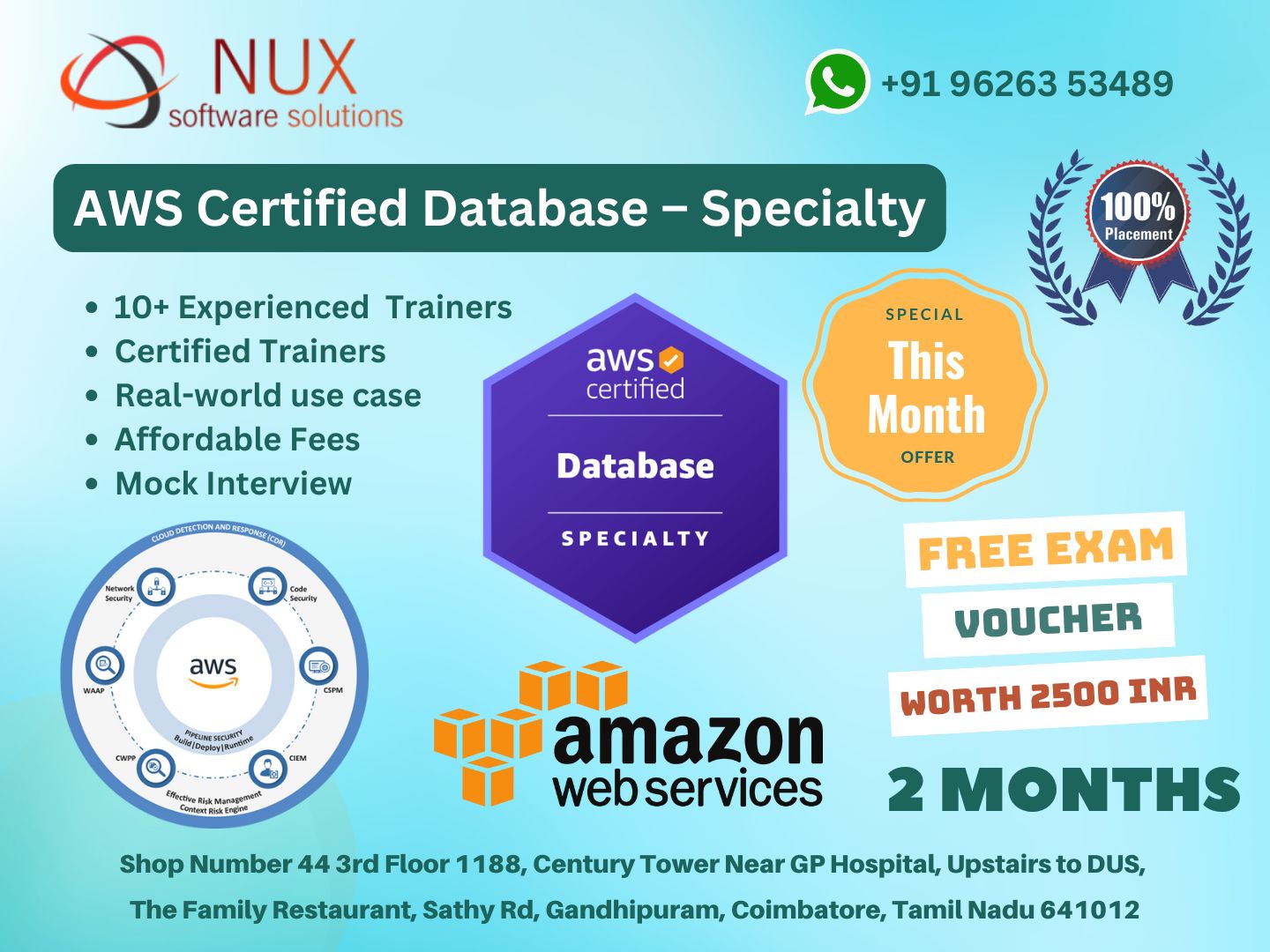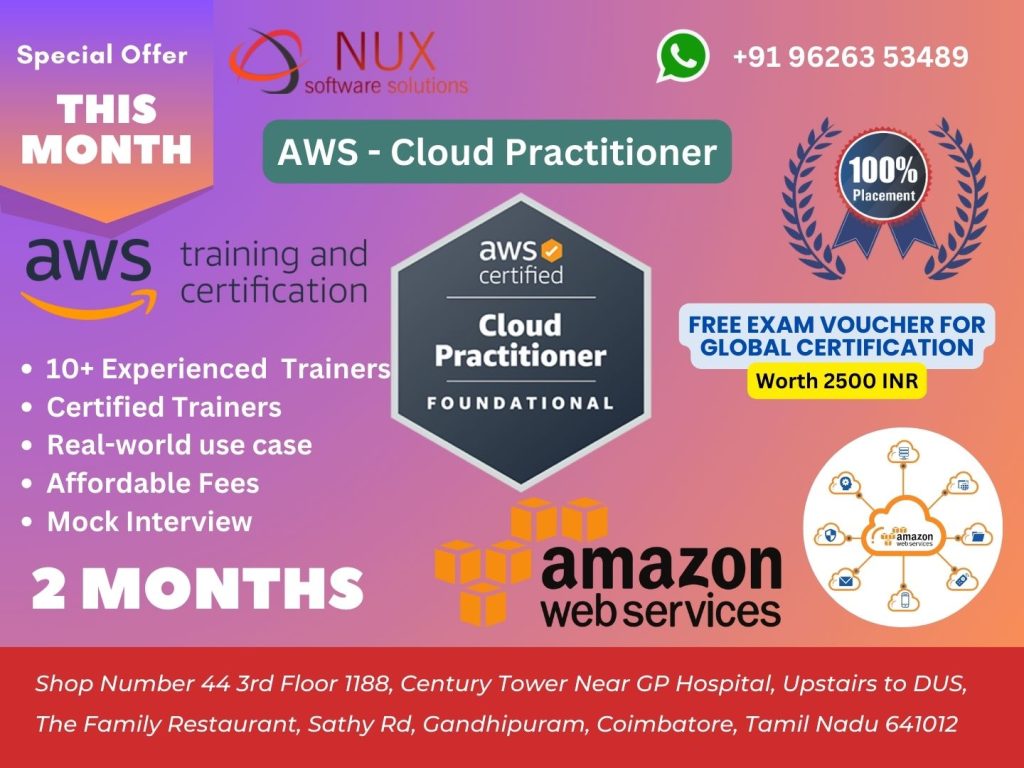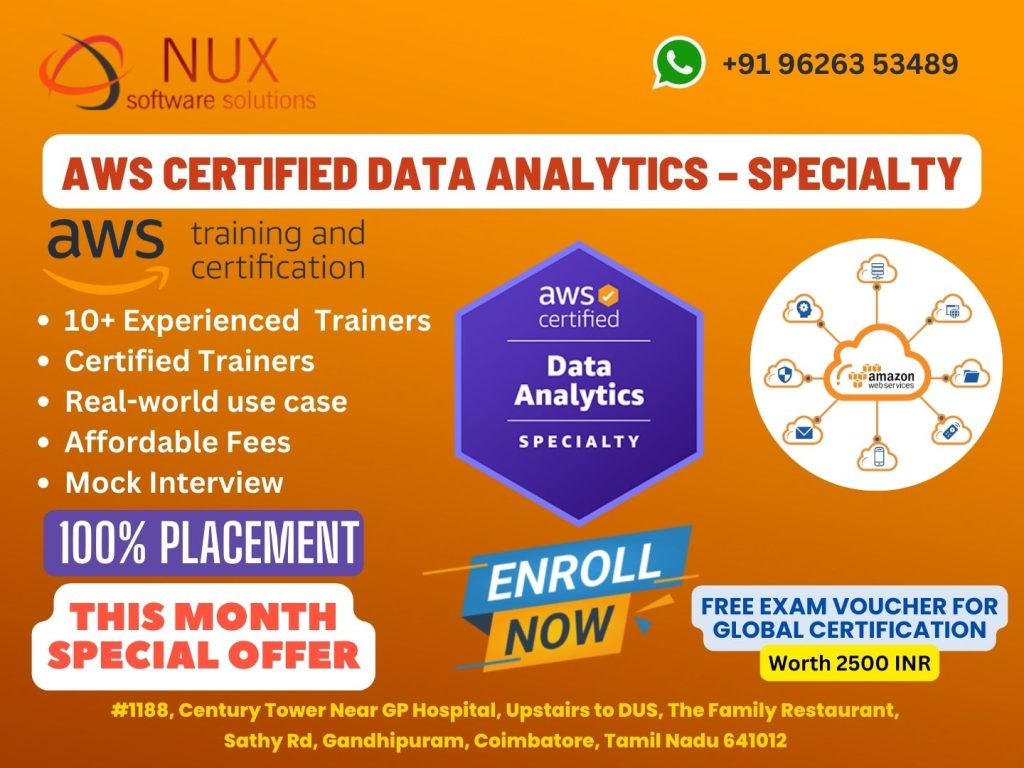AWS Certified Database – Specialty (DBS-C01)

Best AWS Certified Database – Specialty Training Courses in Coimbatore
The AWS Certified Database – Specialty (DBS-C01) certification is tailored for IT professionals who specialize in the design, implementation, migration, and management of database solutions on Amazon Web Services (AWS). This course provides a comprehensive understanding of all AWS database services, helping learners choose the most suitable tools and configurations based on organizational needs.
At our Linux Training Center in Coimbatore, we offer a hands-on, project-based learning environment that prepares you for real-world database tasks and the DBS-C01 exam. Through detailed coverage of both relational and non-relational databases, students gain the skills to architect scalable, secure, and high-performance database solutions in the cloud.
Whether you’re a database administrator, data engineer, or developer, this course helps you confidently work with Amazon RDS, Aurora, DynamoDB, ElastiCache, Redshift, and other critical AWS data services.
Why This Course Matters
With the rapid migration of traditional databases to the cloud, there’s a growing demand for professionals who can design cost-effective, reliable, and highly available database architectures. The DBS-C01 certification validates your expertise in using AWS database technologies and demonstrates your ability to make informed, strategic decisions based on business requirements.
What You Will Learn
-
In-depth understanding of AWS-managed database services
-
Database design principles for performance, availability, and scalability
-
Migration strategies from on-premises to AWS using DMS and SCT
-
Comparison and implementation of relational vs. NoSQL databases
-
High availability, disaster recovery, and backup solutions
-
Database monitoring, tuning, and optimization techniques
-
Security best practices including encryption, IAM, and compliance
-
Data warehousing with Amazon Redshift and real-time caching with ElastiCache
Who Should Enroll?
-
Database administrators and engineers
-
Cloud architects with a focus on data storage
-
DevOps engineers and developers managing database solutions
-
IT professionals pursuing the DBS-C01 certification
-
Anyone involved in data migration, data security, and architecture on AWS
Prerequisites
-
Foundational knowledge of AWS Cloud services
-
Experience working with relational and non-relational databases
-
Prior completion of AWS Certified Solutions Architect – Associate is beneficial but not mandatory
Course Benefits
-
Full alignment with the DBS-C01 certification exam objectives
-
Real-world lab sessions with guided projects
-
Latest curriculum updated to reflect current AWS services
-
Preparation for complex database migrations and high-availability setups
-
Access to experienced AWS Certified Trainers
-
Support with resume building and interview preparation
Career Opportunities After Certification
Completing this course and earning the AWS Certified Database – Specialty credential qualifies you for in-demand roles such as:
-
AWS Database Specialist
-
Cloud Database Engineer
-
Solutions Architect – Databases
-
Database Migration Consultant
-
Cloud Infrastructure Engineer – Data Services
AWS Certified Database – Specialty Syllabus
Workload-Specific Database Design – 26%
Select appropriate database services for specific types of data and workloads.
- Differentiate between ACID and BASE workloads.
- Explain appropriate uses of types of databases (e.g., relational, key-value, document, in-memory, graph, time series, ledger).
- Identify use cases for persisted data compared with ephemeral data.
Determine strategies for disaster recovery and high availability.
- Select Region and Availability Zone placement to optimize database performance.
- Determine implications of Regions and Availability Zones on disaster recovery and high availability strategies.
- Differentiate use cases for read replicas and Multi-AZ deployments.
Design database solutions for performance, compliance, and scalability.
- Recommend serverless compared with instance-based database architecture.
- Evaluate requirements for scaling read replicas.
- Define database caching solutions.
- Evaluate the implications of partitioning, sharding, and indexing.
- Determine appropriate instance types and storage options.
- Determine auto scaling capabilities for relational and NoSQL databases.
- Determine the implications of Amazon DynamoDB adaptive capacity.
- Determine data locality based on compliance requirements.
Compare the costs of database solutions.
- Determine cost implications of DynamoDB capacity units, including on-demand capacity compared with provisioned capacity.
- Determine costs associated with instance types and automatic scaling.
- Design for costs, including high availability, backups, multi-Region, Multi-AZ, and storage type options.
- Compare data access costs.
Deployment and Migration – 20%
Automate database solution deployments.
- Evaluate application requirements to determine components to deploy.
- Choose appropriate deployment tools and services (e.g., AWS CloudFormation, AWS CLI).
Determine data preparation and migration strategies.
- Determine the data migration method (e.g., snapshots, replication, restore).
- Evaluate database migration tools and services (e.g., AWS Database Migration Service [AWS DMS], native database tools).
- Prepare data sources and targets.
- Determine schema conversion methods (e.g., AWS Schema Conversion Tool [AWS SCT]).
- Determine heterogeneous compared with homogeneous migration strategies.
Perform and validate data migration.
- Design and script data migration.
- Run data extraction and migration scripts.
- Verify the successful load of data.
Management and Operations – 18%
Determine maintenance tasks and processes.
- Account for the AWS shared responsibility model for database services.
- Determine appropriate maintenance window strategies.
- Differentiate between major and minor engine upgrades.
Determine backup and restore strategies.
- Identify the need for automatic and manual backups and snapshots.
- Differentiate backup and restore strategies (e.g., full backup, point-in-time, encrypting backups cross-Region).
- Define retention policies.
- Correlate the backup and restore to recovery point objective (RPO) and recovery time objective (RTO) requirements.
Manage the operational environment of a database solution.
- Orchestrate the refresh of lower environments.
- Implement configuration changes (e.g., in Amazon RDS option groups and parameter groups, or DynamoDB indexing changes).
- Automate operational tasks.
- Take action based on AWS Trusted Advisor reports.
Monitoring and Troubleshooting – 18%
Determine monitoring and alerting strategies.
- Evaluate monitoring tools (e.g., Amazon CloudWatch, Amazon RDS Performance Insights, database native).
- Determine appropriate parameters and thresholds for alert conditions.
- Use tools to notify users when thresholds are breached (e.g., Amazon Simple Notification Service [Amazon SNS], Amazon Simple Queue Service [Amazon SQS], CloudWatch dashboards).
Troubleshoot and resolve common database issues.
- Identify, evaluate, and respond to categories of failures (e.g., troubleshoot connectivity; instance, storage, and partitioning issues).
- Automate responses when possible.
Optimize database performance.
- Troubleshoot database performance issues.
- Identify appropriate AWS tools and services for database optimization.
- Evaluate the configuration, schema design, queries, and infrastructure to improve performance.
Database Security – 18%
Encrypt data at rest and in transit.
- Encrypt data in relational and NoSQL databases.
- Apply SSL connectivity to databases.
- Implement key management (e.g., AWS Key Management Service [AWS KMS], AWS CloudHSM).
Evaluate auditing solutions.
- Determine auditing strategies for structural and schema changes (e.g., DDL).
- Determine auditing strategies for data changes (e.g., DML).
- Determine auditing strategies for data access (e.g., queries).
- Determine auditing strategies for infrastructure changes (e.g., AWS CloudTrail).
- Enable the export of database logs to Amazon CloudWatch Logs.
Determine access control and authentication mechanisms.
- Recommend authentication controls for users and roles (e.g., IAM, native credentials, Active Directory).
- Recommend authorization controls for users (e.g., policies).
Recognize potential security vulnerabilities within database solutions.
- Determine security group rules and Network ACLs for database access.
- Identify relevant VPC configurations (e.g., VPC endpoints, public subnets compared with private subnets, perimeter zone).
- Determine appropriate storage methods for sensitive data.



